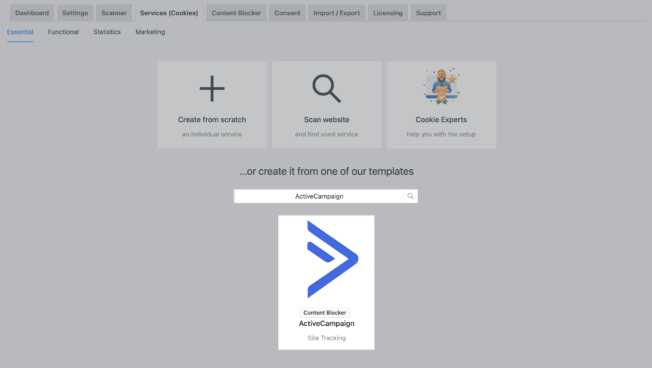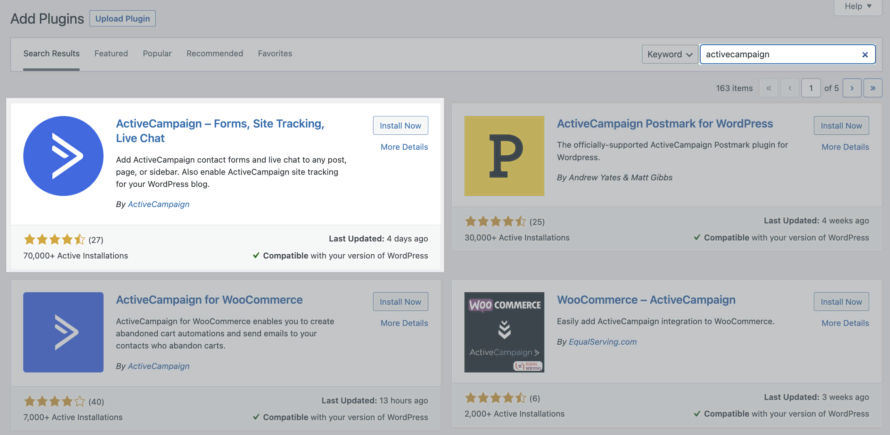You want to integrate ActiveCampaign into your WordPress website to place newsletter registrations or similar? No problem! In this article, we’ll show you how you can easily link the popular marketing tool to your website – and, most importantly, how to do it in a privacy-compliant way!
What is ActiveCampaign?
ActiveCampaign is a cloud software platform from the US company ActiveCampaign LLC, which combines email marketing as well as CRM and marketing automation. Thus, ActiveCampaign is in direct competition with similar solutions such as MailChimp and Sendinblue.
The all-in-one marketing tool thus helps you to expand your online marketing strategy, for example, by optimizing your sales and marketing processes in order to increase customer satisfaction. And as we all know, satisfied customers are loyal customers 😉 ActiveCampaign is particularly suitable for small and medium-sized companies. Detailed user profiles can be created and activities tracked.
In order to automate processes as best as possible, ActiveCampaign provides functions such as chatbots.
Like other marketing tool providers, ActiveCampaign LLC offers a corresponding WordPress plugin to embed registration forms easily and quickly into your website and to integrate site tracking.
Is ActiveCampaign privacy compliant?
If you want to embed ActiveCampaign into your WordPress website, you should take some precautions, because otherwise you can commit privacy violations faster than you think. As a result, you could face heavy fines.
Why?
ActiveCampaign LLC is a US-based company. Before July 16, 2020, this wouldn’t have been much of a problem, comparatively speaking. However, on that day the Privacy Shield – a data protection agreement between the US and the EU – was declared invalid by the EU. The reason for this decision was/is the inadequate level of data protection in the USA. Since then, the USA has been considered an insecure third country in terms of data protection.
Consequently, the transfer of personal data to the USA may in principle only take place on the basis of opt-in consent.
So the problem with integrating ActiveCampaign into your WordPress website is the data transfer to the USA.
How to use ActiveCampaign in WordPress in a privacy compliant way
ActiveCampaign and privacy – a touchy subject, as you’ve just discovered
Nevertheless, in order to integrate ActiveCampaign with WordPress in the best possible GDPR-compliant way, we recommend you to comply with the following points.
Processing contract
You should sign a so-called contract processing agreement (AV agreement). An AV contract is based on Article 28 of the GDPR and is usually required whenever you commission an external company to process personal data. Accordingly, the contract regulates the data protection-compliant handling of this data.
Data protection statement
In addition to the order processing contract, you must also mention ActiveCampaign in your privacy policy. And mention here does not mean simply list, but explain in detail for what purpose you use ActiveCampaign on your WordPress website, what data is transferred, to whom it goes, etc.
When signing up for your newsletter, your recipients should confirm that they have read and agree to your privacy policy by checking a checkbox.
ActiveCampaign and the double opt-in
Last but not least, we encourage you to make sure that you collect signups for your newsletters using the double opt-in process.
This means that the recipient sends the registration and then receives an e-mail with a confirmation link (or similar), which he or she uses to verify the registration. This way, you as the newsletter sender can ensure that the owner of the e-mail address really requested the registration.
In addition, the double opt-in process helps you to comply with your verification obligation according to Article 7 of the GDPR and thus to use ActiveCampaign in a way that is as compliant as possible with the GDPR.
In addition to the double opt-in process used for newsletter signup, you should also get a “stinkin’ normal” opt-in consent for using the ActiveCampaign plugin.
Why?
As already explained, the ActiveCampaign plugin can be used to set up site tracking. This uses cookies to uniquely identify the user and track them across multiple subpages.
If you’ve been reading the article diligently up to this point, you know for sure that you therefore need consent to use the plugin.
The easiest way to get this is via Real Cookie Banner, a cookie consent plugin – as well as one into data transfer to the US. Quasi a two-in-one solution 😉
You can easily find the template for ActiveCampaign site tracking in the template catalog. So you don’t have to care about anything except clicking Save 😉
By the way: The template is already available in the free version of Real Cookie Banner!
Integrating ActiveCampaign into WordPress
Now that we’ve got all the legal stuff out of the way, let’s finish up by showing you how you can add ActiveCampaign to your WordPress website. This is super easy with the help of the plugin ActiveCampaign – Forms, Site Tracking, Live Chat.
Here’s how:
- Open your WordPress backend
- Go to Plugins > Install in the left menu.
- Search for ActiveCampaign. Install and activate the plugin.
- After installation, you will find it on the left menu under Settings > ActiveCampaign.
- After that, you need to link your ActiveCampaign account to your WordPress website by entering your API Key and API URL. You can find both in your ActiveCampaign account. To do this, click Settings > Developer. in your account.
- Copy both your API Key and your API URL and paste them into the corresponding fields.
- Click the Connect button to complete the connection.
- Done! Already ActiveCampaign is linked to WordPress and you can blithely place signup forms on your website.
The created forms each get an individual shortcode. This you can simply copy and place anywhere on your website to display the form there. The shortcodes are structured as follows: [activecampaign form=ID].
Install ActiveCampaign tracking code
You can easily enable site tracking in ActiveCampaign.
- Go back to the left menu to Settings > ActiveCampaign.
- In the Install Code section you will find the Install ActiveCampaign code. Activate this by toggling the toggle.
You now have the option to choose between two tracking methods: Track by default and Don’t track by default.
Track by default: By default, the IP address of known contacts (without their consent!) and page visits are recorded.
Don’t track by default: Known contacts are not tracked without their consent. We have already explained in detail how you can get this consent the easiest and fastest way 😉 .
Don’t forget to save your changes!


